Ornaments and the Concept of Beauty in Iranian Architecture (Case Study of the Large Timcheh of Qom Bazaar)
Shaham Asadi1 * , Mehrdad Farrokhi2 , Alireza Jozpiri3 and Amir Lotfi4
1
Department of Architecture,
Higher Education Institute Rozbeh,
Zanjan,
Iran
2
Department of Architecture,
University of Mohaghegh Ardabili,
Ardabil,
Iran
3
Department of Architecture,
Islamic Azad University,
Hidaj,
Iran
4
Department of Architecture,
Higher Education Institute Rozbeh,
Zanjan,
Iran
Corresponding author Email: Shahamasadi@gmail.com
DOI: http://dx.doi.org/10.12944/CWE.10.Special-Issue1.81
Creation of beauty in Islamic architecture is based on the principle of ornament and it is conceptually composed of two dimensions of frame and meaning. Its inner meaning is infused with religious thoughts and contemplations rooted in our traditional prototypes. Iran had witnessed beauty on the basis of ornamentation during different governmental periods of Achaemenian period or after Islam until the end of Ghajar Dynasty. Because of modernism and western thoughts, some of Iranian architectures had followed western techniques and images and took guard against traditional architecture, but the only things that survived from this confrontation were ornaments such as parget, brickwork, and tiling. A lot has been said about Bazar and its developments, but there are many studies regarding ornaments of Bazar and its traditional models; in this paper we investigated the large Timcheh of Qom from structural, skeletal, spatial points of view and the role that its current Ornaments play in creating a coherent atmosphere in order to introduce it briefly. In Iranian architectural studies, this Timcheh has been underestimated, while it has beautiful and invaluable Yazdibandi’s[i] and Rasmibandi’s[ii], which demonstrate total concept of the absolute beauty for beholder. In this paper which is analytical and research based, and data collection was through field research, library studies and internet. We try to demonstrate an image of Ghajar architecture which is structurally and ornamentally based on our longtime and traditional models.
Copy the following to cite this article:
Asadi S, Farrokhi M, Jozpiri A, Lotfi A. Ornaments and the Concept of Beauty in Iranian Architecture (Case Study of the Large Timcheh of Qom Bazaar). Special Issue of Curr World Environ 2015;10(Special Issue May 2015). DOI:http://dx.doi.org/10.12944/CWE.10.Special-Issue1.81
Copy the following to cite this URL:
Asadi S, Farrokhi M, Jozpiri A, Lotfi A. Ornaments and the Concept of Beauty in Iranian Architecture (Case Study of the Large Timcheh of Qom Bazaar). Special Issue of Curr World Environ 2015;10(Special Issue May 2015). Available from: http://cwejournal.org?p=709/
Download article (pdf)
Citation Manager
Publish History
Select type of program for download
| Endnote EndNote format (Mac & Win) | |
| Reference Manager Ris format (Win only) | |
| Procite Ris format (Win only) | |
| Medlars Format | |
| RefWorks Format RefWorks format (Mac & Win) | |
| BibTex Format BibTex format (Mac & Win) |
Article Publishing History
| Received: | 2015-02-02 |
|---|---|
| Accepted: | 2015-04-01 |
Introduction
Ornament is a kind of imitation from nature. In the creation of human being and other creatures and also in the creation of the skies and the earth, there is ornament (Javadi, 2006, p. 53). Javadi further argues that human imitation from nature is a kind of model making which influence all dimensions of human life such as portance, cloth, adornment and etc. He argues that modern thought has been effected by humanist thought which underwent huge changes and transformations with dissemination and explanation of Francis Bacon doctrine, in sucha way that it is different and in contrast to the past an traditional concept of beauty; because the principles of the contemporaneous thoughts in criticizing naturalism and following blatant positivism are modern, in a way that sometimes it grows as anti-naturalism and anti-unification. Allah states in verse 26ofAlaraf Surah with reference to adornment of human being with raiment of pious: “O you Children of Adam! We have bestowed raiment upon you to cover your shame, as well as to be an adornment to you. But the raiment of righteousness, that is the best. Such are among the Signs of Allah, that they may receive admonition!” Ornaments in the Eastern art has been for explaining the beauty and exiting the sense of individual admiration, but there are different meanings and concepts which are hidden behind these ornaments that are usually rooted in mythologic and religious beliefs of the kinfolk and the overall aesthetics in Iranian art is based on the principal of ornament.
Ernest Konel in the book “Islamic Art” states: “the effortless try that has done to show the form of leaf and stem of grapevine ornamentally, can well demonstrate the style and creation of Arabesque (Konel, 2009, p.22). Konel also like most of the western commentators and researchers considers ornaments of Islamic art as Arabic and attribute sit to Arabs while the ornaments which can be seen in Sasanid palaces and plaster work of that period are mostly herbaceous because Arabs never had a unified civilization and government before Islam to embark on these kinds of artistical innovations, and it was after conquering Iran that they could familiarize with Iranian Styles and ornaments and could accommodate them with their religious thoughts and contemplations. Insistence and confirmation that Iranian had in protection and maintenance of some constructional rules and architectural styles in ornaments and Amodkari[i] such as the architectural styles of the towery tombs, was significant to architecture. Using these kinds of Amodkari in architecture of the Bazaar is ample that we will discuss in this article.
Ornaments and embellishments which were used in the Bazaar not only made it prettier but also played a crucial role in creating a favorable and open atmosphere. Bazaar in cities before and after Islam has been considered as the vital artery of the city and for this reason the important elements, expansions and constructions such as public squares of the city, caravansaries and schools were constructed in its neighborhood. It is of elements of Timcheh that Soltanzadeh writes: “The word ‘team’ has been considered as caravansary, as Naser Khosroo has used this word in his itinerary and Timcheh had been as a small team or small caravansary, but the contemporary caravansaries or small and covered lodges are called Timcheh” (Soltanzadeh, 2008, p.86). Such as the large Timcheh of Qom which from the point of Islamic ornament has beautiful elements of Yazdibandi , Rasmibandi that resulted in spatial coherence and created the best state in ornament with the use of bricks. Considering that the art of Ghajar dynasty is an interim art. It is somehow the middle point between Iranian traditional art and the modern art and indeed is considered as the transition period of Iranian art from its ingenuous and traditional patterns to its new forms and modern inclinations (Shafizadeh & Rajabi, 2009, p. 60). This perspective leads to human Decline into a material subject who seeks comfort, and ignores his essence. We have to consider our culture, identity and so on as well as the environment. Iran’s architecture is full of treasures, made by our ancestors, and without these treasures a building is just steel, brick, cement and naturally (Asadi & Farrokhi, 2015, p.15). And this interim can also be seen inside the Timcheh, but in the present paper our aim is to represent the beauty and ornaments of Timcheh as a significant structure in Iran’s architecture.
Definition of Bazaar and its Social Role
Bazaar in the Persian dictionary of Moen has several meanings: “1- a place for selling and buying commodities and viands; 2- a covered alley which had markets on its both sides, marketplace” (Moen, 1985, p. 452). In the middle Persian, Bazaar has been used as Vazaar and with combinations such as Vazarg (emporetic) and Vazarganand in Parti language has been used as Vazhar (Peroshani, p. 305). This word has entered in English language which is written as (Bazaar). Hafez in his lyrics says: “a graceful bird like you how long would greed bone / alas that shade of will that you bestowed on ignorant - in this Bazaar if there is any profit with Dervish, he is happy / O my God bestow upon me this Dervishi and happiness ” (Hafez, 1985, 440th lyric, p. 599). Or in other place says: “the rose bud’s smiling face, whose attention will it grace / whom do you wish to embrace O Rose bud, tender & meek?
In the marketplace today your buyers willingly pay / be alert and stash away ri`ches in your lucky streak” (Hafez, 1985, 495th, p. 678). Bazaar can be considered into a public space in the city; In addition, public space can be defined as a scene displaying social life, whether these activities are routine and permanent or ceremonial and periodic. These functions include political, religious, commercial and sport activities. The major characteristic of public space is that it “describes the collective life, urban culture and routine debates, and also impacts them” (Farrokhi Kaleybar, Asadi & Rashid Kalvir, 2014, p.448).
Bazaar is one of the most dynamic and active city centers that considered as the beating heart of the city and the majority of collective activities and city transactions took place in this place which is functionally and semantically very significant. The point that gave significance to Bazaar had been both the role of nudinals and its structure in notifying and increasing people’s knowledge in both political and social dimensions which has continued from the past until now. Hossien Soltanzadeh writes in the book “Iran’s Bazaars”: “nowadays, when we refer to Bazaar, at first and generally its economic dimension is discussed, while in the past in addition to this characteristic, its social and urban role was much more significant than today, because bazaar in its way was directly or indirectly related to city centers and public atmospheres of the city and news and rumors also were dispersed in this way” (Soltanzadeh, 2008, p. 108).
Historical background of Qom Bazaar:
As picture 1 shows the old bazaar is placed inside the primary core of Qom city, i.e. localities of Lab Chal and Arabestan. Construction of the majority of its divisions has been during Safavid Dynasty and some of the needed structures have added during Ghajar dynasty. The expansion of the bazaar during Naser Aldin Shah’s period and formation of the new bazaar, has taken place concurrent with the emergence and development of Astaneh locality. Because of the centrality of Astaneh locality, the new bazaar gained prominence from economic point of view. In this period, three Timchehs were concurrently built by Master Hassan Memarbashi in Qom city:
Large Timcheh
topic of the present paper.
Middle Timcheh
belonged to Amin Alsoltan which was at the center of Salamatgah bazaar.
Small Timcheh
belonged to Inhesar Aldoleh.
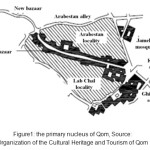 |
|
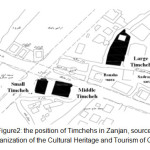 |
|
About 1940 because of the construction of two intersecting roads of Azar and Astaneh in the agenda of expanding Qom, the two large and middle Timchehs were demolished. Therefore, beside the large Timcheh an array of Saras[i] on the south side of the new bazaar such as Banaha’s Sara, Sadrazam’s Sara, Haj Abbasgoli Khan’s Sara, Sheen’s Sara, Hamdaniansara, Haj Asghar Khan’s Sara, Haj Asghar Khan’s mosque and bathhouse acted as auxiliary places of Qom bazaar (Organization of the Cultural Heritage and Tourism of Qom). With regard to the present map and the neighborhoods that can be seen in it, following the other bazaars Qom bazaar configures the economic center of the city which is related to many kinds of applications (usages) and acted as a the backbone of cities. The importance of bazaar was very significant on the rate of traffic and development of the city.
The Large Timcheh of Qom
The large Timcheh of Qom (pictures 2 and 3) is on the north side of the new bazaar. This construction is one of the valuable heritages of Iranian Islamic art which was planned and created in 1923 by Hassan Qomi the prominent artistic of Naseri era who was famous to Memarbashi. The founder of this construction was departed Haj Sayyed Mahmoud Tabatabee, the famous merchant of Qom. From the beginning it was constructed for trading carpenter and today the carpenter isthe most important product of Qom industries. It seems that the fame of this industry in Qom and introduction of carpenter and its economic advantage have been effective in the creation of Timcheh (Organization of the Cultural Heritage and Tourism of Qom).
The platform scenery holding about two third of the length of Timcheh, is 30 meters long and its widest part is 15 meters (the central orifice). This atmosphere is covered with three basic vaults and under the three basic coverings we can see very beautiful Yazdibandi and Karbandi[i] which are incomparable in their ilk.
The plan of this place is composed of two half waterfront (a square which two angles that have been paned) and a waterfront in the middle. In all of the panes there are very beautiful Muqarna (Honeycomb work or Stalactite work) ornaments which are plastered and the largest model of these Muqarna ornaments are created with an incomparable mastery in the upper section of the alcove porch (Organization of the Cultural Heritage and Tourism of Qom). In addition to following Iranian elements and oldfanglism in the context of the bazaar, the available ornaments in this atmosphere and its adornments show a specific kind of fondness in the realm of construction that the more a person looks at it and ponders about it, the more beautiful and symmetry the Karbandies seems and is the reminisce of Imam Hassan Mojtaba’s (peace be upon him) saying: “Allah is graceful and loves beauty and I adorn myself because of my creator-nurturer” (Majlesi, V. 83, p. 175).With this statement, Imam considers beauty not only physically but also spiritually. And understanding this kind of beauty in Timcheh evokes this thought that the inherent beauty in ornaments and construction is for Allah and approval of His word in order to be a sign of Allah presence.
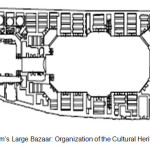 |
Figure 3: The plan of Qom’s Large Bazaar: Organization of the Cultural Heritage and Tourism of Qom Click here to View figure |
Ornaments (Lexicology)
Ornaments in the Persian dictionary of Moen mean “adorning, ornamenting, and neatening” (Moen, 1982, V. 1, p. 1078). However, it should be considered that ornaments are only used to beautify pure material aspects and there is no spiritual thought behind it. Ornament is not something added, deluxe and inflictive on art, but in traditional arts called decorative-applied arts, ornament is the art itself (Javadi, 2006, p. 53).
Pirniya says that: “the philosophy of ornament in art is creation of beauty that sometimes had been on the basis of recreation of nature in an exemplary, allegoric and fantasticway and sometimes is based on the basis of longings, wishes and imaginations of artiststhat reflects his people and society’s wishes (Javadi, 2006, p.54). The holy Quran in Fosselat sureh verse 12 says that: “And we adorned the lower heaven with lights”. Allah presents his power by adorning and decorating the skies with lights. Malekolshoarye Bahar in 184th elegy “From the Prison of Shah” says: “until the end of the world, be the king of the world / the world has gained ornament from your justice and fairness” And in another place Amir Khosro Dehlavi writes from the book” Matlaolanvar” “because the body of Adam was decorated from soil / the home of soul was decorated for the sake of heart” (Dehlavi, 1975). Using this word with the meaning of adorning and decorating in poetical literature are so rampant that these are only a few examples of these significant poems.
History of Ornaments in Iran
Ornaments in Iranian architecture has ahistory of several thousand years that is shared with the nature of Iran’s architecture ,from wall drawings which is created by combination of iron oxide and juice of fruits to brickwork, tiling, and the acme of molding in different Islamic ages which wasmarvelous. Arthur Upham Pope acknowledges the use of glace bricks in Ilamid architecture in 12th century B.C. which used in blue, green colors in Choghazanbil and blue and yellow colors in Shoosh (Pope, 2009, p.18). In Persepolis architecture we can also see ornaments as embossments. Moreover, decorative embroideries of Persepolis are carefully sampled and their circular surfaces are expression of a live creature. In the luminancesimilar to dawn, some of these impressions numinously seem live (Pope, 2009, p.38).
In Islamic ages also most of the architectural constructionsand elements had a history earlier than Islam. About adornments and ornaments too this past approach was followed. Dr. Nogreh Kar says that the work of evaluating skeletal system of constructions is as follows: “in the first decades of using herbal and geometrical illustrations, which were rampant in the past architecture of Sasanid and Byzantium, then with regard to the view of Islamic culture in reverence of sculpturing and drawing, this procedure headed towards abstraction and abstract geometry. During the sixth, seventh, and eighth centuries it arrived the acme of geometric impressing, during the Turkish Seljuk it reached the supreme rate in using brickwork in mason, and after that during Moguls and Timurid period tile was added to molding and brickwork. At first we can find a combination of tile and brick, then a uniform tiling during the Timurid and Safavid ages, and ultimately the incomparable acme of ornaments in glass works of shrines that by their geometry, light and color settle human being in a galactic atmosphere which belong to the supreme world (Nogreh Kar, 2009, p. 590). On the one hand, architectural adornments absorb beholders minds to artificial and external beauty of embroideries and application type of constructive atmospheres thatimages and adornments are placed on its walls, and on the other hand, open eyes of the beholder to the realm of cultural and religious secrets and ideograms covered in the concept of images. By understanding the symbolic concepts of embroidery of adornments in decorative architecture and finding their roots, we can recognize the mind and thought of thearchitectures and therefore can reach people’s culture and their worldview and aims (Balilan Asl et al., 2012, p. 85). All over the history, the formation of Iranian architecture has accompanied with ornaments that acted as the body and the soul of the building and was not a separate thing, but constantly manifested the godly world in a way that Sheikh Mahmoud Shabestari in “Golshan Raz” (the Garden of Secret) says: “not being is the mirror of absolute Being / therein is reflected the shining of “The Truth” _ not being is the mirror, the world the reflection / and man is as the reflected eye of the unseen person” (Shabestari, 2009, p.134). The image of not being in front of the absolute Being is like mirror in front of sun in a similar way that when a picture is reflected in the mirror, it follows the quality and quantity of the mirror and this represents that all of the possibilities follow an absolute and unlimited Being.
Ornaments and Beauty in Islamic Thought
Pope writes in his book “Persian Architecture” that: “a gracious and masterly wall adornment (ornaments) has fortunately been renewed with modern innovations in each era. Approximately all of the architectural ornaments were abstractive, except some of wall pictures and mural epigraphs and also these epigraphs because of their pure planography are very attractive. However, these ornaments are absolutely miraculous in realm of styles, application of materials, type of plans, power of explanation, spiritual interference and purity” (Pope, 2009, p. 11).
Muslim artist embarked on creation of ornaments which their major elements were geometric patterns and abstract images, and this kind of approach resulted in creation of a frame which has completely an allegoric state and by creating dimensions and ornaments including geometric images and Islamic embroideries, explained a particular sense and thought with “monotheism” as the most important topic. Geometric images explicitly explain unity in multitude and multitude in unity (Madad Poor, 1996, p.135). In decorative architecture, every image has a value beside its physical face that is taken from culture manifesting continued belief and aim of population of the society in its past and future generations. Frithjof Schuon in his article “Truths of Errors Concerning Beauty” did not consider the concepts of grace and beauty in ornaments or preciosity as prerequisite valuable, but considers utility of mason as prerequisite of beauty (Schuon , 2012, p. 34), he further argues that “the complete understanding of beauty, the beauty that calls us to this means that we should go beyond its guise and follow its inner meaning to reach the principals of that meaning” (Schuon , 2012, pp. 36-36). Molasadra has compared Allah’s illustration and role playing in the universe and its adoration with different adornments and beauties with human being’s illustration and aesthetics that he creates in his own productive and industrial actions. As picture 4 shows, he cites this verse of the Holly Quran “creating human being on the basis of his face” in his comparison. Therefore, whatever comes to being in the human being world from the point of grace and beauty, whether attributes oractions of human being, all are a face and manifestation of Allah’s name (Imami Jomeh, 2010, p. 26).
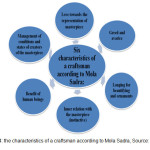 |
|
This factor represents the importance which an architecture or artist depends on it as a thought frame, that results in change and transformation in the nature of matter and this is the meaning of grace in beauty which is present in Shamsehs[i] and embroideries of the construction of the large Timcheh. Titus Burckhardt writes in his famous article “perennial values in Islamic Art” with reference to the prophets saying that “verily Allah has written merci on everything” grace and beauty of everything is in its thank and adoration to Allah or in other words everything is graceful or beautiful to the extent that represent one religious attribute (Burckhardt, 1998, p.75). This approach of idealization in exemplary image has been represented deeply and beautifully by Molavi in a reading of Leili (Beloved) and Majnons’ (Lover) love. At first, he begins as the following: “Khalife once said to Beloved that it is you / whom Lover became perturbed for your sake - you are not more beautiful than other beloveds / Beloved answered that be silent since you are not Lover (Majnon) ” (Molana, 1984, pp.407-408).
Creation of allegory and approaches that are seen as criterion of beauty in ornaments is not based on pure beauty, but depends on the look of addressee and the understanding that he takes in to accountprincipals and rules of Islamic art in his mind. These rules are so many and manifest in large Timcheh of Qom.
Application of vacant atmosphere in Islamic art is one of the important direct products of the metaphysical principal of monotheism in art, because approximately all different aspects of Islamic art, somehow have relations with this principle and its branches in the multiple world (Nasr,1997, p. 179). However, it should be considered that arriving to the issue of monotheism through metaphysical explanation is not a very optimal approach because hermeneutic and metaphysical discussion developed in direction of modern rationalism and tries to justify issues beyond nature in the realm of human rational. Nasr explains two views about the principle of monotheism and its manifestation in verse “there is no god except Allah” and considers it as one of the deepest metaphysical rules which has two meaning levels: one is an emphasis on transient and unreal nature of all creatures (everything except Allah), i.e. the total of creation system and physical world except Allah; and the other is an emphasis on truth and the absolute Being that is Allah is beyond the things that human mind can imagine and create a picture of Him and this has a significant role with the word “God”. He further writes: “Islamic embroideries provide this possibility for vacant atmosphere that can penetrate the matter’s frame, cleans darkness from it and luciferase it in front of “Godly light”. By the help of using Islamic adornments in different forms, vacant atmosphere inters in different dimensions of Islamic art and delivers material things from their heavy silencing center and allows spirit to breathe and expand (Nasr, 1997, p.181). Nasr argues that using these embroideries and adornments as representative and symbolic in order to erase the lack of humane images or embodiment of divinity and the human being should concentrate on his inner side and this will result in enhancement of spirit instead of body. And these thoughts can be explicitly seen in figure 5 that how the light opens the atmosphere and penetrates in the frame of matter. This kind of view in Islamic art includes an understanding which negatively excludes body from ornament circle and includes spirit instead of it. Allah is incomparable. His power is so inclusive that He says in 115th verse of Bagareh (the Cow): “To Allah belong the east and the West, wherever you turn there is the presence of Allah, for Allah is all-Pervading, all-Knowing”.
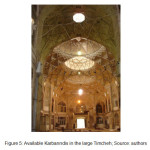 |
|
Kinds of Ornaments in Islamic Architecture and the large Timcheh of Qom:
Ornament of building in Islamic architecture is an important and inseparable element of architecture, and has a clear manifestation in brickwork, parget and glasswork and is the product of the efforts and works of artists who work hardly in order to make the art of this country graceful and enduring. In table 1, classification of some of the architectural ornaments of Timchehs been provided.
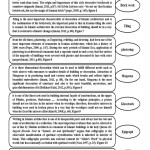 |
|
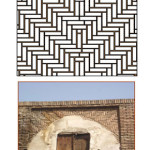 |
Figure 6: Brickwork of Khofte Raste, source: authors Click here to View figure |
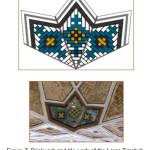 |
Figure 7: Brickwork And Tile Work Of The Large Timcheh (Muqarna) With Tile Pattern, Source: Authors Click here to View figure |
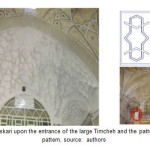 |
Figure 8: Fillet muqranskari upon the entrance of the large Timcheh and the pattern of inscriptive fillet pattern, source: authors Click here to View figure |
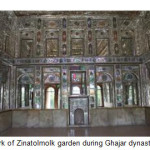 |
|
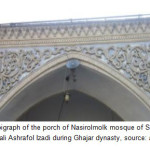 |
|
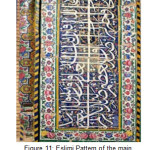 |
|
Recognition and understanding of beauty among the old races have been on the basis of regarding nature and following it in the form of decorative presentation. The philosophy of ornament in Iran’s art is creation of beauty and application of it and this profit is sometimes material and sometimes spiritual (Javadi, 2006, p.52). Mohammad Hassan Zaki in “Iran’s Art” classifies its art into five categories with regard to Islamic embroideries and ornaments: plant forms, humane images, animal images, book’s handwriting and geometric patterns (Zaki, 1999). In all of these embroideries and ornaments, there is a kind of balance and tranquility that brings about unity of façade and internal atmosphere. The most important production that Iran’s architecture brought about during Ghajar dynasty is the glasswork of that period, albeit there is no trace of this kind of ornament in the construction of the large Timcheh. In the realm of architectural ornaments the inner façade of buildings, during early periods of Ghajar was rampant with parget and tiling in the inner façade of buildings, but with crossing from this era and entering into Pahlavi era, application of complex ornaments in inner atmosphere of buildings decreased. With regard to acceleration of construction and application of modern materials in building, a change resulted in the rate of using inner ornaments of building. Ornaments in Islamic architecture in overall are classified into the above mentioned categories, but for the sake of better analysis and understanding of this subject we will refer to some of the ornaments which are used in the large Timcheh.
“Wooden Ornaments”
wooden ornament of Timcheh construction are only represented in Orrosi[i] (Box head window) windows of the first floor which application of these ornaments of wooden knotting in opening Orrosi provided ample beauty to inner surfaces and facades of building. Unfortunately, because of disregarding on the part of marketers and officials intervention in this building and lack of enough attention these precious elements are on the verge of demolishing and some of these remaining Orrosi windows do not have any application even in some case sliding sashes of these Orrosies are deleted and instead metal windows are used. An example of wooden window can be seen in picture 12, if we pay a close attention to its knotting, we can explicitly see the spirit of Iranian art in it. Overall, there are 12 Orrosi widows in this building (the rest has been demolished) which are mostly used in the first floor and the place of these Orrosies are shown on the plan (picture 13). In this pattern, the type of knotting of the underneath frame of windows are used in the following pattern of that nodulation in door lets of Orrosi (Organization of the Cultural Heritage and Tourism of Qom).
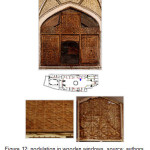 |
|
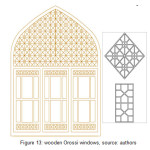 |
|
Rasmibandi
to what extent the construction of the large Timcheh is poor regarding the previous mentioned ornaments (except the wooden nodulation in Orrosies), to that extent this building has very beautiful and unique ornaments of Rasmibandi ,Yazdibandi. These kinds of ornaments that are created very carefully and masterly by Master Hassan Memar are unique in their kind and it can be said that throughout Iran, this construction is the only version regarding application of this ornament (pictures 14, 15).
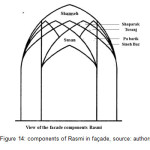 |
|
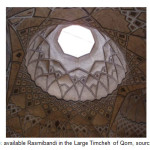 |
|
Yazdibandi
is a state between Rasmi and Muqarna that its key of drawing and application are planks which are placed on circles with centrality of Shamseh like Muqarnas trains each Board by board have the same height difference. By deleting horizontal planks we can adapt from Rasmi and create Yazdibandi(Organization of Cultural Heritage and Tourism of Gom). Rasmibandi is usually used in places which either Rasmi cannot be used or Muqarna will be expensive to use. As it can be seen planning and application of Yazdibandi is simpler and cheaper (pictures16, 17).
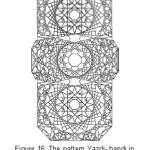 |
|
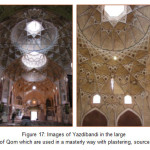 |
|
Plan of Rasmibandies underneath domical covering (cap) joint to entrance corridor and the way of its surface division which is applied masterly with various brick knots. In the above plan, ornaments of Rasmibandi under threefold caps of the main salon have been separated from the existent Yazdibandies.
Meaning and Application of Ornaments in Iran’s Architecture
Iranian genius by way of planning has reached to the deepest concepts of ornament in the realm of physical and external beauty. In architecture without a doubt simple and voluminous forms had their special values, and provided infrastructures for ornaments. Inherent symbolic nature in Iranian planning which is along with the respect of human image and other natural images, has provided significant seriousness and care for Iranian embroideries and adornments which is unknown in western culture (Pope, 2009, p. 132). According to Pope, ornaments have symbolic nature that not only is created for beauty, but also for giving meaning to environment in order to provide more grace and immortality to the building.
Hog writes about embroideries and ornaments: “in embroidery and adornment of Islamic constructions, there is a characteristic that does not bring about a sense of activity and volatility and conversely provides a frame for his mind to discover, observe and see the inner side” (Hog, 1997, p.20). Hog also considers Iranian ornaments along with a kind of semanticism that paves the way for human being to think and ponder in the imaginary world. For this reason the applied ornaments in the Timcheh, not only attract human being towards himself, but also take him from the body to the soul.
Dr. Nogreh Kar also writes in this case that “Islamic thought has completely denied ornament, but advances the acceptance and ornamentof what is spiritual and religious and results in attention of human being to the spiritual and religious issues. Therefore, monotheist artists have optimally applied the most abstract material elements in their ornaments that can induce the excellent spiritual and religious concepts in beholder. Using abstract geometric lines, forms and patterns in surfaces and volumes of building (Building facade, juncture of volumes, Capitals, networks, fences and etc.) and in geometric structure of atmosphere, artists could induce a colorful, combined and infinite atmosphere and bring the mind to spiritual truths” (Nogreh Kar, 2009, p. 617). He argues that the existent ornaments in Islamic constructions are full of meaning that has their roots in allegoric world and this conveys the capability of Iranian architectural artist that in a clear way tries to represent rules that manifest a clear and immortal atmosphere. This meaning is clearly seen in picture 18 and the available Yazdibandis in the construction is an example of unity and is the witness of flying from earth and to sky and creation of Shamseh in space results in a suspended and vacant atmosphere.
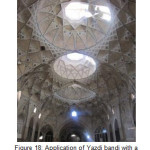 |
|
But Helin Brand argues that available ornaments in Islamic constructions results in deforming the structural role of building that can be regarded as both inviting and suspending element in the building. He further argues that: “obscurity and illusion in the field of ornament in more advanced than this matter. Internal tiling of domical of Shah Mosque (Isfahan) creates light reflections that seem as sun is beaming through it. Apparently the aim is that domical to be relatively unreal and imaginative or in fact clear. If a wall has been decorated in the best way, the attention is certainly will be absorbed to ornaments and to the same extent the effect of construction as a pure architecture will decrease, therefore, architecture and ornaments are always in a constant contest. The unusual and important role that Islamic architecture considers for ornament guarantees its victory on the one hand and destruction of form on the other hand. As though that wall has only been a large “canvas” (HillenBrand, 2008, p. 62). Obscurity in form and ornaments that HillenBrand speaks about them in Islamic architecture and her unclear imagination of Islamic architecture is a useless and laughable speech, because she argues with thoughts and beliefs that cannot considered more than surface review and classification regarding Islamic philosophy, when she considers high building and public construction as ambitious and in order to create obscurity and hallucination; she may misrepresented place of imaginary and discovery of witness which take place in the imaginary world in the heart of godly man (wise). And that considering the beautiful ornaments and tile work of Alireza Abbasi in the Shah mosque as canvas and regarding it as resulting in destruction of form and structure is weird. Because these ornaments not only does not create obscurity in the form, but also has made it more beautiful and coherent and will result in more observation of human being. The blue color in domical of Shah Isfahan and its bondage with sky as the caller of unity represents a serious harmony which ties sky to earth. Ornaments and adornments that are used in very single element of Islamic buildings with a complete grace and coordination from the bottom of nature and for the natureare used in the inside and outside of the building in way that cannot separate them from each other. The total existence of the construction of Timcheh are composed of unlimited amplification which at the end have reached a manifest and sensible unity in order to be a sign of absolute soul, that has always and everywhere on our architecture. Hillen Brand with such a view not only does not know anything about the formation of Islamic architecture, but also has a wrong understanding regarding the thoughts and doctrines existent in it.
Schuon in the article “Principles and Criteria of Art” writes about ornament and its root in Islamic art: “Islamic art regarding its origin, is originated from the form of the Holy Book, i.e. interwoven letters of its verses and also- even if it looks contradictory- from prohibition of images” (Schuon, 2012, p. 119). He further argues that this issue results inenhancementand creativity in other ways and regards it as permission for the images of plants, Eslimi, and geometric concepts. That not only does not lead to obscurity, but also gives clarity and purity to construction that creates a religious atmosphere.
Physical Structure and Coherence of the Atmosphere of Timcheh
One of the cases understood after confrontation with this atmosphere in the characteristics of is the unity and coherence of atmosphere. That is its application despite its variation is done in a way that looks like members of a chore group that all of them play a harmonic rhythm. Indeed this atmosphere includes different elements of constituents, architecture and ornaments that each of them is a unique and beautiful element, but is combined in a beautiful way. Several concepts play crucial role in creation and transmission of this sense:
Physical Consistency of Construction
Because of a specific consistency of wall and roof, there is unified atmosphere that recognition of their border and joining points is not simple. Lines of Toveyzeh[i] are transformed into a rooms by elongation and tree like expansion that creates a beautiful body of construction for viewer and as Burckhardt writes about Islamic art: “for a Muslim, art to the extent that is beautiful, without having any sign of mental or individual inspiration, is only the “evidence and proof of Allah’s existence”; its beauty like a sky full of stars should be impersonal. In fact, Islamic art reaches grace in a way that it seems to be independent from its creator, its glories and faults are evaded in front of general character of forms” (Burckhardt, 2014, p. 137). This sky full of stars is decorated in a best way with geometric lines and forms.
Materials and Color
As shown in image 19, using bricks with gray color and its combination with Toveyzehes that are bleached by plaster recalls art of Sasanid period that were used during Abbasid periods, too. Konel considers available ornaments of Aw13qbasian dynasty of Iranian patterns and writes: “in Abbasid period, parget covering is used to decorate construction surface by using brick in construction works.In this technique that had been remained from that period, looks a kind of tradition and this tradition was not anything other than abstract pattern of array of these patterns in an innovative way (Konel, 2009, p. 37).
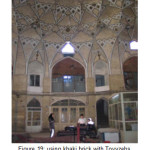 |
|
However, the art of tiling of Ghajar era is not based on the basis of glorification period of Seljuk tiling and not in the scale of artistic period of very diverse brick works of Safavid period. But in Ghajar period, brick works with various and new embroideries were rampant and brick and its role playing in it is in sample constructions although it has been extensively used in the context of brick works or in the form of frame building from the role of tile or other cases. In Ghajar period, using attractive brick Karbandies with elements such as Sineh Baz (Open chest), Hafti Jame (seven collections), Pa Barik (Slim Leg), along with Toranjies (Bergamot) until arrival of Samboseh and Shamseh has been rampant (Organization of the Cultural Heritage and Tourism of Qom). (See the figure 14). This useful coordination and harmony in selection of the type of material because of artist’s talent and basic thought that is used in his mind as an ideology represent graceful place of architecture as an artist in planning the Timcheh. Iranian because of the love that they had towards flower, pasture and garden, have used these descriptively and definitively in their poems. Molana believes that Allah has created the world with colors that result in thought development in human being. And this shows the available geniusin formation of construction in order to create a special beauty by using the existent and available materials which is semanticist, and every bit of building manifests ascending to higher unity and optimal truth which is a play of the absolute beauty of creator, that are inherent in hands of artists and resulted in creation of an artistic work. In a way that there is no fault or weakness in the soul of building and is a sign of godly attributes. Shamsehs and penetrations that are used in the building have the sense of a poet who with a complete grace looks in sky and awaits a lover whose mercy is infinite and his lightmake the tired and old hearts constant that brings about the happiness of soul and body of human being in this distressful world.
Discussion and Conclusion
Aesthetics of Iranian art is based on ornament; ornament is not only a kind of imitation and inspiration from nature, but also includes insight from Islamic beliefs and thoughts. Ornament is some a religious art because it has dimensions that are more or less subsidiary not inherent and from a religious point of view has supreme effects on function and nature of architectural elements that most of the time are mystic and allegoric and understanding of this matter is possible only through interpretation. Manifestation of religion in art is only by way of creation and representation of dimensions, images and forms that are combined with religious principles and reached supremacy in it. In a way that the principle of ornament in addition to religion is related to myth and most the times is the basic meaning of ornament.
During Ghajar period which is an era of innovation or restructuring, there were many developments in the realm of architecture that effected the physical and elemental structure of building and mixed it with western patterns that had no conformity with Islamic and Iranian architecture, however, Iranian architecture brought itself out of this commotion and could confront this event by its last hopes. As it can be seen from the available ornaments and adornments of the large Timcheh, the Yazdibandies and brick adornments that somehow represent inner discovery and seeing in the imaginary world that is movement from body to soul (outside to inside). Totality of this subject is tacit in Islamic thoughts; that it has denied ornament unless it has been an explanation of godly happiness and a sign of spiritual and religious concepts.This explanation represents the concept of beauty that relates body and soul in Islamic art and creates a symbol of immortal unity. Although the construction of Timcheh is structurally similar with other Timchehs that are built during Ghajar period(Aminoldoleh Kashan and Sadrazam Qom), but the things that differentiates it from other constructions are complex and full Rasmibandies and Yazdibandies which are used in the roof of the building and resulted in good looking and calls the person in the entrance to the building to the upper world that is the acme of aesthetics which the artists has reached in the realm of Islamic thought and understands it. The beauty that encompass the soul and body of human being in the entrance to Timcheh familiarizes him more with the masterpiece of Iranian architecture that not only results in spiritual permutation in human being, but also enhances his thoughts and views in old traditions and beliefs. At the end the arena of Iranian mentality has always beamed in the darkness of history and we can see and sense this not only in architecture but also in all of the Iranian thought and philosophy.
Fotnotes
- Yazdibandi: a certain type of Karbndi under dome is an arched cover of entrances which decoratively gives a particular view to the space taken over an extensive area.
- Rasmibandi: is a method of Karbandi which is created by inter sectctions of several arches on the Toronbe and Pabarik ha
- Amodkari: the decoration that is add after the end of its construction, an additional ornament, stone, brick, tile and plaster viewing (Pirniya, 2009: p.350)
- Sara: or Khan has been known as a trading place. A sample of material has been taken from it and is distributed in different places (Pirniya, 2006: p.128).
- Karbndi: is a kind of covering composed of individual vaults with specific arch which intersect each other according to geometric rules and creates the major shape of the covering (Pirniya & Bozorgmehri, 1993, p.1)
- The visual and symbolic “Shamse” (Sun) has gained a significant position in Iran’s art and has attracted artists during different periods. This pattern has many symbolic concepts. Before Islam, the sun disc had been a niche which the divine light reached the ground by going through it, during the periods after Islam refers to as the symbol of divinity, light and unity. Moreover, in many religious and literary sources, the sun has been mentioned as a symbol of the Prophet Muhammad (PBUH).
- Orrosi: has been of Iranian architectural elements and grilled window which instead of flipping on the heels goes up and then falls in a crate which is placed on it, which can be seen on the floor of the palaces, façade and porch of buildings in mountainous areas.
Toyze: the main ribs of the covering of floor, leaf-mold, frame, arch which are made by plaster and straw (Pirniya, 2009: p.350).
Reference
1. Asadi, SH. And Farrokhi, M. The challenges of sustainable development and architecture. International Journal of Science, Technology and Society, 3(2-1),11-17 (2015).
2. Balilan Asl, L., Sattarzade, D., Khorshidiyan, S. and Nori, M. Decorated with Islamic geometric characteristics of the nodes in the view of fractal geometry. Iranian Journal of Islamic Studies, 6; 63-96 (2012).
3. Bolkhari Gahi , H. Spiritual Foundations of Islamic Art and Architecture (Unity and the unity of intuition-alchemy of imagination). Second Edition, Publications of Sooreh Mehr, Tehran (2011).
4. Burckhardt, T. Perennial Values in Islamic Art. Translated By Dr. Seyyd Hossein Nasr, Proceedings 1, the Office of Religious Studies Art, Second edition, Sooreh Press (1998).
5. Burckhardt, T. Foundations o6f Islamic Art. Translated By Amir Nasri, Hagigat Press, Tehran (2008).
6. Burckhardt, T. Sacred Art: Principles and Methods. Translated By Jalal Sattari, Sixth edition, Soroush Press, Tehran (2014).
7. Dehlavi, A. Kh. Informed Lights (first Masnavi Khamse), the correct premise Tahir Ahmad Oghloo Muharram Of, Moscow (1975).
8. Farrokhi Kaleybar, M. ,Asadi ,SH. And Rashid Kalvir, H. The Role of Public Urban Spaces in Creating a Vivacious Society: A Case Study in Tabriz, Iran. European Online Journal of Natural and Social Sciences, Vol.3, No.4 Special Issue on Architecture, Urbanism, and Civil Engineering (2014).
9. Hafez Shirazi, M. Court of Sessions [Divan Ghazaliyat]. Efforts Dr. Khalil Khatib Rahbar, first edition, Safi Alishah Press, Tehran (1994).
10. HillenBrand, R. Islamic Architecture. Translated by Dr. Iraj Etessam, Press Processing and urban planning, Third edition, Tehran (2008).
11. Hog, J. Art and Architecture in Islamic lands; Translator: Pervez Varjavand, Elmi va Favhangi[Scientific and Cultural] publishing, Tehran (1997).
12. Imami Jomeh, M. Philosophy of art in Mollasadra love. Second Edition, Art Institute of Matn, Tehran (2010).
13. Imani, A. Symbolic expression of Islamic architectural ornament. Book of the Month Art, 142; 86-93 (2011).
14. Javadi, Sh. Decorate the main element in the aesthetic art. Nazar Garden Journal, No. III,51-57 (2006).
15. Konel, E. Islamic Art, Toos press, Tehran (2009).
16. Majlesi, M. B. Behar-Alanvar.VOL. 83 (1996).
17. Madad Poor, M. Expressions of spiritual wisdom in Islamic Art. Amir Kabir Press, Tehran (1996).
18. Moen, M. Persian culture medium, Volume III, Fourth Edition, Sepehr Press, Tehran (1985).
19. Molana, J. Masnavi Manavi. A special effort Reynolds Elaine Nicholson, Ninth Edition, published by Amir Kabir, Tehran (1984).
20. Nasr, H. Islamic Art and Spirituality. Translated By Rahim Gasemiyan, Office of Religious Studies Art, First edition,Tehran (1997).
21. Nogreh Kar, A. Introduction to Islamic identity in architecture and urbanism. Department of Housing and Urban Development, First edition, Tehran (2009).
22. Organization of the Cultural Heritage and Tourism of Qom. Project identification, documentation, restoration projects large Bazaar Timcheh Qom. Mehraz Saze Compani, Qom.
23. Peroshani, I. Bazaar Term. Encyclopedias of Islam, article marketing.
24. Pirniya, M. K. Style of Iranian architecture. Collected by Gholam Hosseyn Memariyan, Soroush Press,Tehran (2009).
25. Pirniya, M. K. Introduction to Islamic Architecture of Iran. Collected by Gholam Hosseyn Memariyan, Soroush Press,Tehran (2006).
26. Pirniya, M. K. and Bozorgmehri, Z. Geometry in architecture but also in all of the Iranian thought and philosophy. Reference 689 Asadi et al., Curr. World Environ., Vol. 10(Special Issue 1), 672-689 (2015) in Iran architecture. Sobhan noor press, Tehran (1993).
27. Pope, A. U. Persian Architecture. Translated By Gholam Hossein Sadri Afshar, The Seventh edition, Akhtaran Press,Tehran (2009).
28. Schuon, F. Truths and Errors Concerning Beauty. Art and spirituality (collection of essays on the philosophy of art), Schoun, Guenon, Coomaraswamy, Nasr,…; Compilation and Translation Inshallah Rahmati, Matn Press, Tehran (2012).
29. Schuon, F. Principles and Criteria of Art. Art and spirituality (collection of essays on the philosophy of art), Schoun, Guenon, Coomaraswamy, Nasr,…; Compilation and Translation Inshallah Rahmati, Matn Press, Tehran (2012).
30. Shabestari, Sh. M. Golshan Raz [the Garden of Secret]. Correction by Amir Hossein Khanji, Tehran (2009).
31. Shafizadeh, P. & Rajabi, M. A. Drawings of the court (official) Qajar magnificent view image. Negareh Journal, No. 6, 58-69 (2009).
32. Soltanzadeh, H. Iranian Bazaar. Publications Office of Cultural Studies, Tehran (2008).
33. Zaki, M. H. Persian Art. Translated by Ebrahim Oglidi, Sedaye Moaser press, Tehran (1999).






